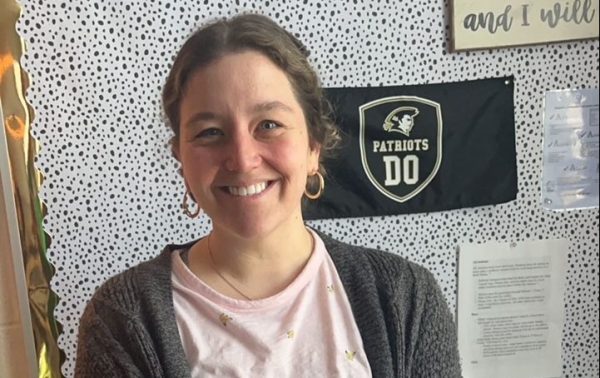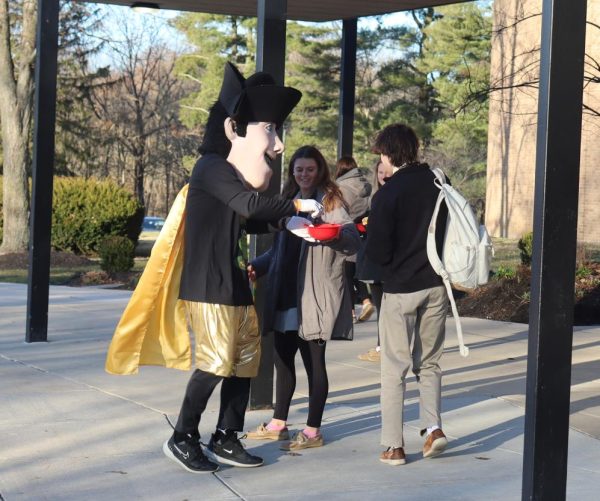Nurse Webster does her part as a COVID-19 tester in Forest Hill, MD
May 1, 2020
She arrives at work around 9:30 AM and starts to “don and doff” her PPE. She carefully puts on her gown, gloves, hair cover, N-95 mask, and face shield. Her body is entirely covered to reduce her risk of obtaining the virus. Cars start to line up at the drive thru, anxiously waiting to be tested. JC School Nurse Michelle Webster ’81 has been working as a COVID-19 tester since March 16, just three days after Maryland schools were officially let out due to the coronavirus.
In 2010, Mrs. Webster began working a part-time job for Health Link, an organization made up of about 30 nurses from the community health sector of Upper Chesapeake Hospital. Regularly, her job involved working two to four days a month out in the community doing vaccines and educating the public about multiple nutritional campaigns.
When the Coronavirus struck Maryland, Director of Community Outreach at Upper Chesapeake and JC alum, Vickie Bands, reached out to the nurses of Health Link for their help. “School’s out,” said Mrs. Webster, “I told Vickie to put me wherever I was needed.”
The nurse’s first job consisted of conducting “fit-tests” for every employee at Upper Chesapeake and Havre de Grace Memorial Hospitals receiving an N-95 mask. “It was labor-intensive. The fit-tests took around ten minutes each,” said Mrs. Webster. The nurses started this task on March 16 and finally finished during the week of April 19.
Out of the 30 nurses involved with Health Link, five or six nurses were willing to volunteer for the second task as mobile COVID-19 testers. Nurse Webster now works four days a week at the mobile COVID-19 testing station set up at the Forest Hill Vehicle Emissions Inspection Site. Mrs. Webster was trained and put to work.
Before testing begins, Nurse Webster explained that it is important to follow the don and doff procedure with her PPE (personal protective equipment). Amid the news reports that many healthcare workers are in need of masks and equipment, Mrs. Webster claimed, “We’ve been very lucky to have all of the PPE at the amount that we need. I feel protected.”
As for how the testing site works, the working nurses have it down to a science to optimize efficiency. Before patients are to be tested, they must have a doctor fax over a doctor’s order. The patient must then call the command center and schedule a COVID test after the doctor’s order has been verified. If a person was to arrive at the testing site without a doctor’s order, he cannot undergo testing.
A nurse at the end front end of the drive thru starts the process by checking for the correct paperwork. Upon the approval of paperwork, the car is sent to Nurse Webster who then double checks the paperwork and proceeds with testing. The test itself is either nasal or oral swabs, “whatever the lab sends.” “I actually prefer the nasal swab because the oral swab usually triggers a gag and coughing, which puts us more at risk,” said Mrs. Webster. She then places the sample in its designated place and informs the patient with information pertaining to disinfecting their homes, the importance of social distancing, and what to do if their symptoms worsen.
After four hours in the cold, Mrs. Webster starts her going-home procedure. “There is a very specific way to remove the clothing to avoid contaminating yourself. I get home and basically undress outside and leave my outer layer in a special bag. I race across my house and immediately get into a hot shower. I then put gloves on and deal with my clothing. I even wipe down my car with wipes. I call my children before I come home to let them know I’ll be home soon”
This experience has been eye-opening for Mrs. Webster. “I forgot how much I loved working with other nurses. When I’m at school, I have to make all of the medical decisions by myself but now I can confer with other nurses.” She is also surprised by how many organs COVID-19 can affect. “There’s people with kidney failure, COVID toes. I’m surprised by the extensive damage that it can do to your body,” she explained.
“The first week I worked [at the mobile testing site], we saw about 30 patients. This last Friday we saw 107 patients. We are all learning as we go,” commented Mrs. Webster on the current situation. She plans to continue working for the testing site as long as she is needed and as long as school is not in session.
“If I had known that day that I would never see the seniors in their uniforms again, I wouldn’t have squandered my time with them. I thought I had more time!” said Mrs. Webster.






